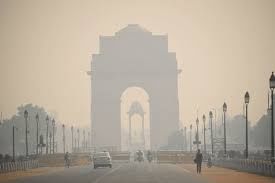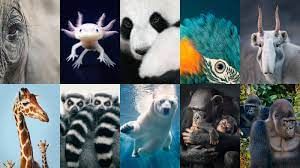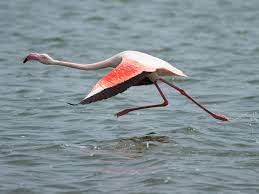Class 8 Science Chapter 5 Question Answers - Conservation of Plants and Animals
Q1: Define wildlife sanctuary and national parks with examples.
Ans: A wildlife sanctuary is an area where animal habitats and their surroundings are protected from any sort of disturbance. The capturing, killing and poaching of animals is strictly prohibited in these regions.
Examples: Sanjay Gandhi Wildlife Sanctuary, Asola Bhatti Wildlife Sanctuary, etc.
 Sanjay Gandhi Wildlife SanctuaryNational Park: It is an area reserved for wildlife where they can freely use the habitats and natural resource. National park contains extremely important habitats and species. This is protected areas in which human interference are not allowed.
Sanjay Gandhi Wildlife SanctuaryNational Park: It is an area reserved for wildlife where they can freely use the habitats and natural resource. National park contains extremely important habitats and species. This is protected areas in which human interference are not allowed.
Examples: Corbett National Park, Sunderban National Park, etc. Sunderban National ParkQ2: Explain deforestation and its causes.
Sunderban National ParkQ2: Explain deforestation and its causes.
Ans: Deforestation means clearing the forest or stands of trees, and using that land for other purposes.
 DeforestationMain causes of deforestation include:
DeforestationMain causes of deforestation include:
- Procuring land for cultivation
- Building houses and factories
- Making furniture or using wood as fuel.
- Some natural causes of deforestation are forest fires and severe droughts.
 Forest Fires
Forest Fires
Q3: What are the consequences of deforestation?
Ans: Consequences of deforestation:
(i) Soil erosion
(ii) Loss of biodiversity
(iii) Floods and droughts
(iv) Climate change due to global warming
(v) Disruption of water cycle Soil erosion
Soil erosion
Q4: What are the effects of deforestation on soil?
Ans:
- Deforestation leads to soil erosion due to the absence of tree roots that tightly hold soil in place.
- Cutting down trees results in the detachment of roots from soil, leaving it vulnerable to erosion.
- Forest removal eliminates natural protection mechanisms, aggravating the erosive effects, especially in sloped terrain.
- The combination of erosion and rainfall in deforested areas can trigger massive mudslides, contributing to significant land degradation.
- Loss of trees and vegetation directly contributes to soil erosion, compounding the environmental impacts of deforestation.
 Land DegradationQ5: What is draught and desertification?
Land DegradationQ5: What is draught and desertification?
Ans: Draught: When there's not enough rain for a long time, it can mess up how water moves around. Deforestation can make this worse by changing the environment and making it harder for rain to fall, affecting plants, animals, and people.
Desertification: When the top layer of soil gets taken away, it reveals hard, rocky ground underneath. This soil isn't as good for growing things, and over time, it can turn land into something like a desert. This process is called desertification, and it makes it tough for plants and animals to survive there.
 DraughtQ6: What do you mean by biosphere reserves?
DraughtQ6: What do you mean by biosphere reserves?
Ans: Biosphere reserves are the large areas of protected land meant for conservation of wild life, plants and animals resources and traditional life of the tribal residing in that area. It helps to maintain biodiversity and culture of that area.
Example: Pachmarhi biosphere reserves. Pachmarhi biosphere reservesQ7: What are the efforts of government regarding taking care of forests and animals?
Pachmarhi biosphere reservesQ7: What are the efforts of government regarding taking care of forests and animals?
Ans: The government establishes different regulations, approaches, and strategies to safeguard and preserve wildlife. They prioritize the creation and management of wildlife sanctuaries, national parks, and biosphere reserves to protect the plants and animals living in those areas.
Q8: Name the national park and wildlife sanctuaries of Pachmarhi biosphere reserves.
Ans: National park named Satpura and two wildlife sanctuaries named as Bori and Pachmarhi.
Q9: What is flora and fauna?
Ans: The plants and animals found in a particular area are termed flora and fauna of that area.
Examples of Flora include Sal, teak, mango, etc.
Examples of Fauna include barking deer, cheetah, leopard, wild dog, wolf, etc.  Flora and FaunaQ10: List the factors disturbing biodiversity of a particular area.
Flora and FaunaQ10: List the factors disturbing biodiversity of a particular area.
Ans: Factors disturbing the biodiversity of a particular area are:
(i) Deforestation
(ii) Air pollution(poisonous gases, smoke from vehicles)
(iii) Industrialization
(iv) Poaching of animals Poaching Q11: How can we prevent biodiversity from getting disturbed?
Poaching Q11: How can we prevent biodiversity from getting disturbed?
Ans:
- By promoting afforestation through extensive planting initiatives.
- By adhering to government regulations and policies aimed at preventing and conserving biodiversity.
 Afforestation Q12: What do you mean by endemic species?
Afforestation Q12: What do you mean by endemic species?
Ans: Endemic species are those species of plants and animals which are found exclusively in a particular area. They are not naturally found anywhere else. A particular type of animal or plant may be endemic to a zone, a state or a country.
Examples of Endemic Flora include Wild mango and Sal.
Examples of Endemic Fauna include Bison, Indian giant squirrel and flying squirrel. Bison
Bison Indian Giant Squirrel Q13: What are the factors affecting natural habitat of endemic species?
Indian Giant Squirrel Q13: What are the factors affecting natural habitat of endemic species?
Ans: Following are the factors affecting natural habitat:
(i) Increasing population which lead to clear land to be used by human beings for various purposes like making building, agriculture, industrialization etc.
(ii) Introduction of new species in their region
(iii) Destruction of forests
(iv) Air pollution Air pollution in Delhi
Air pollution in Delhi
Q14: Explain species.
Ans: Species is a group of population residing together in a particular area and are capable of interbreeding; the members of a species are capable of reproduction by mating with the members of their own species and not with member of other species. SpeciesQ15: Discuss wild life sanctuaries and its importance.
SpeciesQ15: Discuss wild life sanctuaries and its importance.
Ans: A wildlife sanctuary is an area where animal habitats and their surroundings are protected from any sort of disturbance. The capturing, killing and poaching of animals is strictly prohibited in these regions.
Importance: They aim at providing a comfortable living to the animals. India has beautiful wildlife sanctuaries, with dense forests, large rivers, high and beautiful mountains.
Q16: Discuss National Parks and its importance.
Ans: National Park is an area reserved for wildlife where they can freely use the habitats and natural resource. Like Kaziranga National Park, Corbett National Park, etc. National park contains extremely important habitats and species. This is protected areas in which human interference are not allowed.
The main aim of a National Park is
- To conserve and enhance the natural beauty, wildlife and cultural heritage present in it.
- To promote opportunities for the understanding and enjoyment of the special qualities (of the Park) by the public
Q17: What was the aim of launching project tiger by government?
Ans:
- Project Tiger, initiated in 1973, is a wildlife conservation program managed by the National Tiger Conservation Authority in India.
- This program is specifically focused on the preservation of tigers within India.
- Its primary aim is to safeguard and boost the population of tigers across the country.
Q18: Why some animals are called endangered animals?
Ans: The animals which are facing high risk of becoming extinct are called endangered animals. The main reason for this is their diminishing number and they are threatened by changing environmental or predation parameter.
Example: Tiger Endangered Animals
Endangered Animals
Q19: Why dinosaur is called extinct animal?
Ans: The extinction of dinosaurs occurred due to disruptions in their natural habitat, leading to challenges in survival and eventual extinction and this is why dinosaur is called an extinct animal. Dinosaur
Dinosaur
Q20: Name some of the animals that are in danger of becoming extinct.
Ans: Tiger, Panda, some small animals like frog, lizard etc
Q21: Define ecosystem.
Ans: All living and non-living components of environment are together called ecosystem, it includes plants, animals, and microorganisms in an area along with non-living components such as climate, soil, rivers etc.
Q22: Write short notes on Red Data Book.
Ans:
- The Red Data Book documents endangered species, both plants and animals.
- It's separate for animals, plants, and other species.
- Published in various countries, it offers valuable insights into the threat levels faced by different species.
 Q23: What do you understand by migration?
Q23: What do you understand by migration?
Ans: Migration is the behaviour of animals of flying in far away areas every year during a particular time because of change in climatic condition. Birds fly for laying eggs as weather in their natural habitat is not suitable for their survival and for laying eggs. Such birds are called migratory birds. For example: S Flamingos, Siberian Cranes and Night heron. FlamingosQ24: Why is recycling of paper important?
FlamingosQ24: Why is recycling of paper important?
Ans: About seventeen full grown trees are required to produce one tonne of paper. Paper can be recycled around five to seven times for use.
We should save, reuse and recycle paper to save not only trees but also to save the energy, water and chemicals used to make paper. Recycling Q25: Explain reforestation and its useful effects.
Recycling Q25: Explain reforestation and its useful effects.
Ans: Reforestation is the restocking of destroyed forests by planting new trees. We should plant more and more trees. We have already caused a lot of damage to our forests. If we have to regain our green wealth, reforestation is the only option. Reforestation has following advantages:
- Provides more oxygen
- More room for wildlife
- Cut down on CO2
- Saves the planet
 Reforestation
Reforestation
Q26: Differentiate between wildlife sanctuary and Zoo.
Ans:
Wildlife Sanctuary | Zoo |
|
|
Q27: Differentiate between endangered species and extinct species.
Ans:
Endangered Species | Extinct Species |
|
|
Q28: What will happen if the top layer of soil is exposed?
Ans: If the top layer of soil is exposed, then it will gradually expose the lower layer of soil, which is hard and rocky in nature. This type of soil is less fertile as it contains less humus. Continued soil erosion will make the land barren or infertile.
Q29: Why should we conserve biodiversity?
Ans: Biodiversity refers to the number and variety of various life forms like plants, animals microorganisms in an area, plants and animals are interdependent for survival. This means that the destruction of either of the two will automatically effect the survival of other, hence we should conserve our biodiversity to maintain the balance of nature.
Q30: How some tribal depends on the jungle?
Ans: There are some tribal who live in jungle and are totally dependent upon jungle for their food. They gather food, fodders and fallen branches of trees from forest and are dependent upon forest for their daily requirements.
Q31: How does deforestation cause to decrease rainfall?
Ans: Deforestation means that carbon dioxide increases in the atmosphere. It causes global warming as carbon dioxide traps the heat rays reflected by earth. The increase in temperature on earth disturbs the water cycle and reduces rainfall. This could cause droughts.
Q32: How does deforestation lead to a decrease in the water holding capacity of the soil?
Ans: Deforestation also leads to a decrease in the water holding capacity of the soil. The movement of water from the soil surface into the ground is reduced. So, there are floods. The other properties of the soil like nutrient, content texture also change because of deforestation.
Q33: What is biodiversity?
Ans: Biosphere is that part of the earth in which living organisms exist or which support life. Biological diversity or biodiversity, refers to the variety of organisms existing on the earth, their interrelationships and their relationship with the environment.
Q34: How can we protect wildlife?
Ans: Wildlife plays an important role in maintaining balance in the environment. Wildlife can be protected by making special and conserved areas. These areas are restricted for human activities which are against wildlife. Poaching, hunting and cutting of trees are strictly banned. Such areas are called Sanctuaries and National Parks which conserve flora and fauna of earth.
Q35: What do you mean by species? Explain some detailed features.
Ans: Species are group of population which are capable of interbreeding. This means that the members of a species can reproduce fertile offsprings only with the members of their own species and not with members of other species.
Members of a species have common characteristics.
Q36: Which types of animals are much more in danger of becoming extinct?
Ans: The small animals are much more in danger of becoming extinct than the bigger animals. We kill snakes, frogs, lizards, bats and owls ruthlessly without realising their importance in the ecosystem. They might be small in size but their role in the ecosystem cannot be ignored. They form a part of food chains and food webs.
Q37: Write the causes of migration of birds.
Ans: Causes of Migration:
(i) In search of food
(ii) Due to climatic changes
(iii) For laying eggs
(iv) To enjoy long summer days.
Q38: How does recycling and saving of papers related to deforestation?
Ans: Trees are used in making papers. About 17 full grown trees are used to make one tonne of paper. So wastage of paper is also a cause of deforestation. Therefore, we should recycle and save the papers. If we save papers, we can save many trees in a year. In this way recycling and saving of papers is directly related to avoid the deforestation.
Q39: What is the answer for deforestation?
Ans: Reforestation is the answer for deforestation. The reforestation means restocking of the destroyed forests by planting new trees. We should plant as many trees as we cut. If the deforested area is left undisturbed, it re-establishes itself. If we have to retain our green wealth for future generations, plantation of more trees is the only option.
Q40: What do you mean by Forest Conservation Act?
Ans: In India, we have the Forest Conservation Act. This act is aimed at preservation and conservation of natural forests and meeting the basic needs of the people living in or near the forests.
|
92 videos|296 docs|44 tests
|
FAQs on Class 8 Science Chapter 5 Question Answers - Conservation of Plants and Animals
| 1. How can we contribute to the conservation of plants and animals in our daily lives? |  |
| 2. What are some common threats to plant and animal species in today's world? |  |
| 3. How do national parks and wildlife sanctuaries help in the conservation of plants and animals? |  |
| 4. What is the importance of biodiversity in the conservation of plants and animals? |  |
| 5. How can we prevent the extinction of endangered plant and animal species? |  |

















